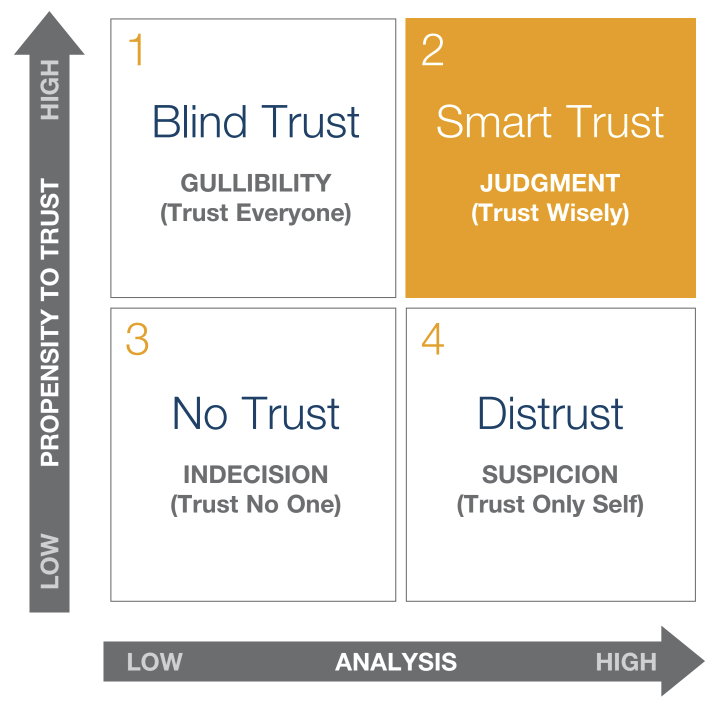The Second Wave: Relationship Trust
A few months ago, we defined “Smart Trust.” Now that we’ve been through all the trust-building behaviors, let’s talk about how to use what you’ve learned to build smart trust with others.

Start with yourself:
Answer these two questions, preferably in writing:
- How do you perceive your own propensity to trust?
- How do you think others perceive it?
Then, add your own analysis:
- What is the current opportunity or situation?
- What are the risks–the odds of possible outcomes? What is the credibility of the other person involved?
Next, use your judgment to decide whether to extend smart trust.
If it’s not time yet, engage in trust building behaviors until it is time.
Finally, once you’ve decided to extend Smart Trust, declare your intent and clarify your expectations.
Keep this a two-process. First, define desired results with the other person, and clarify accountability measures. Second, engage in the mutually agreed-upon accountability measures to make sure you’re meeting each other’s expectations.
What if you know the other person doesn’t trust you?
Here are some steps:
Start with yourself. Focus on giving them something to trust. Ask them, “What can I do to increase your confidence in me?” Then, affirm your intention: “I want to earn your trust, so I’m asking how.”
Listen first and clear up expectations. Repeat what you heard them say and clarify any misunderstandings.
Keep your commitments by delivering results, not activity. Do what you said you would do. Avoid talking about what you promised until you actually have the results. We’ve all had the following experience: someone promised something, then used a lot of energy talking about how they intend to do it and how they’re going to do it and when they’re going to do it, but then it ends up undone.
Practice accountability. Report on your performance in a quick and timely manner.
Make this cycle a habit:
- Make commitments.
- Keep your promises.
- Repeat.
Even small “wins” count. In fact, a bunch of small promises kept can instill more trust than one or two big ones.
Next week: Pointers on developing trust whether the relationship is good or bad.

Thanks for reading,
Alan Feirer
See more blog posts on The Speed of Trust.
#1: Leaders Invest in Trust
#2: Credibility Gaps: Leaders Know the Waves of Trust
#3: Behavior, Credibility, and the Wrong Kinds of Trust
#4: Leaders Know Credibility is Driven by Behavior
#5: Build Trust by Talking Straight
#6: Leaders Build Trust by Demonstrating Respect
#7: Leaders Build Trust by Creating Transparency
#8: Leaders Build Trust by Righting Wrongs
#9: Leaders Build Trust by Showing Loyalty
#10: Leaders Build Trust by Delivering Results
#11: Leaders Build Trust by Getting Better
#12: Leaders Build Trust by Confronting Reality
#13: Leaders Build Trust by Clarifying Expectations
#14: Leaders Build Trust by Practicing Accountability
#15: Leaders Build Trust by Listening First
#16: Leaders Build Trust by Keeping Commitments
#17: Leaders Build Trust by Extending Trust

Leave a Reply